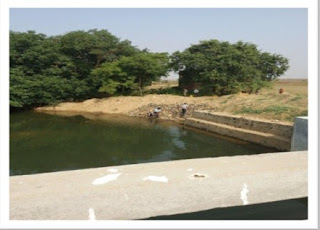Till few years back the
farmers of Rajnagar Block in Birbhum District had to spend a major part of the
season struggling with the adversities of nature to protect their crops. Majority
of the open wells in the village and the big lake have gone dry during Rabi
season.. There were very limited economic activities, drought
had brought life to a halt. This has been a common scene in this drought hit
district of West Bengal until 7 Check Dams were constructed in clusters with
the intervention of World Bank funded West Bengal Accelerated Development in
Minor Irrigation Project(WBADMIP).
With the construction of the Check Dams, Community mobilization activities were carried out under which 202 members were registered for the formation of Water User Association, 25 % of the members belong to Schedule Caste Community and 10 % were female members
In the planning stage, it was envisaged that the irrigated water would be necessary only during Rabi season. However, due to inadequate rainfall during monsoon, there was acute shortage of water in the months of August and September, the water from the Check dams came out to be a sigh of relief for the kharif farmers.
In its
preliminary investigation, ADMI Project officials observed that due to scanty
rainfall farmers in
the area used to cultivate only Kharif crops and during
Rabi season the fields remain mostly dry. Paddy was the only choice which was not
much economically viable at a time when they were already struggling with poverty
and drought. Apart from that, Low literacy and awareness in the area were depriving them from
the modern tools and technology which they were in desperate need to enhance
the productivity of their small and marginal land. Irrigation
was carried out in a sporadic fashion using ‘china’ pump sets without any
coordination among the farmers.With the construction of the Check Dams, Community mobilization activities were carried out under which 202 members were registered for the formation of Water User Association, 25 % of the members belong to Schedule Caste Community and 10 % were female members
In the planning stage, it was envisaged that the irrigated water would be necessary only during Rabi season. However, due to inadequate rainfall during monsoon, there was acute shortage of water in the months of August and September, the water from the Check dams came out to be a sigh of relief for the kharif farmers.
Most
interestingly fact about these Check Dams is that they are saving almost 50% of the paddy crop from the clutches of climatic adversities. In a rough estimation it was figured out that each Check Dam could save upto
half a million INR worth of crops (Assuming per bigha yield is 6 quintals and price per quintal is 1100 INR). Putting all together, the 7 Check dams
could save crops worth 3.5 Million INR approximately during its first season
after handover thus creating a total storage capacity of 17.89 Ha M (145.03 acre feet).
The implementation of a check dam can transform the
agriculture of the surrounding areas. By holding the monsoonal rains for longer
after they have stopped, new and sustained irrigation techniques can be
implemented which will in turn prolong the crop growing season.
This
water is expected to be sufficient at least till the next year’s rains. Other
than recharging the nearby wells, it will also ensure that the source of bore
wells in the village does not dry up.
Earlier,
there was not enough water to farm for more than six months, now with the check
dams the WUA farmers have prepared a crop plan for the Rabi season season as well.
It’s not only the members of WUAs, there
are spill over benefits that extends beyond the project area which is around
250 bighas against a command area of 150 bighas.
(Courtesy: IDS, SPMU)
(Courtesy: IDS, SPMU)



No comments:
Post a Comment